Altan T. Metal Forming Handbook
Подождите немного. Документ загружается.


The roll stand for profile roll changeoveris used for the manufacture of
compact sections with fixed dimensions. However, if spacers are manu-
ally inserted into each stand, it is also possible to manufacture sections
with different widths (Fig. 4.8.22). Both stand types – rigid and with
telescopic roll set – permit the rolling dies to be exchanged by detach-
ing the front stand upright. However, this involves long set-up times.
Drive shaft changeoveroffers a compromise between exchanging indi-
vidual rollers and exchange of a complete stand. At a special work sta-
tion equipped with a suitable crane harness, the upper and lower drive
shafts are exchanged together (Fig. 4.8.23).This helps to avoid set-up
errors and saves the need for a second stand set. The time required for
this changeover process lies somewhere between that required for
exchanging rollers and that required when using pallets for the stands.
381
Bending
Fig. 4.8.20
Roll stands
Metal Forming Handbook / Schuler (c) Springer-Verlag Berlin Heidelberg 1998
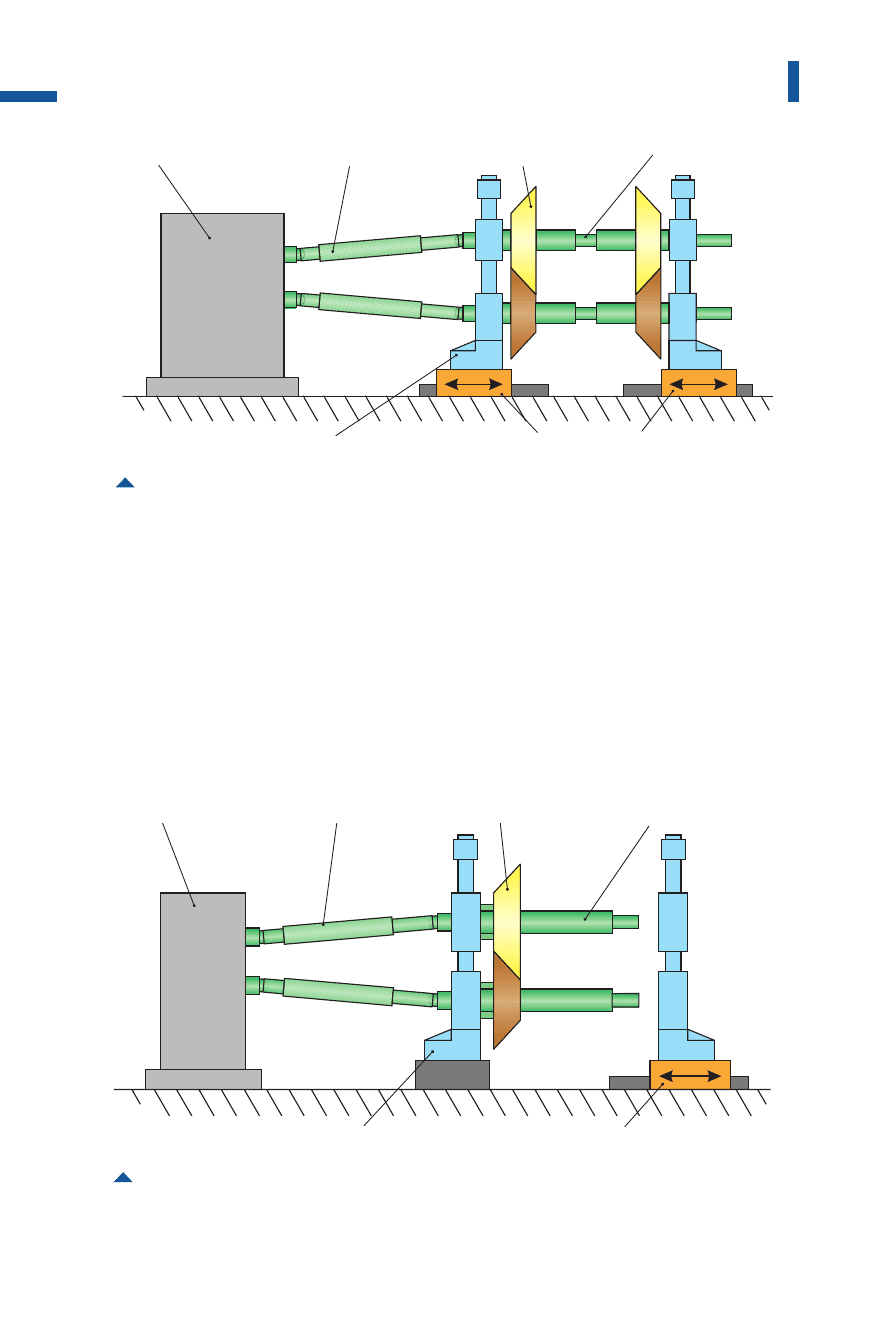
It is also possible to use a separate set of stands for each different sec-
tion. This permits not only fast resetting but also a high degree of process
reliability and repeat accuracy(Fig.4.8.24).For stand changeoverthere are
two different changeover techniques possible:
–Exchange of individual pallets using a crane: Pallet changeover is
advisable where short set-up times are required. The roll forming
382
Sheet metal forming and blanking
Fig. 4.8.21 Width adjustable telescopic roll set
gearbox cardanshaft telescopicshaft
widthadjustment
formingroll
frame
Fig. 4.8.22 Roll stand for exchange of section rolls
gear box cardan shaft forming roll shaft
width adjustmentframe
Metal Forming Handbook / Schuler (c) Springer-Verlag Berlin Heidelberg 1998
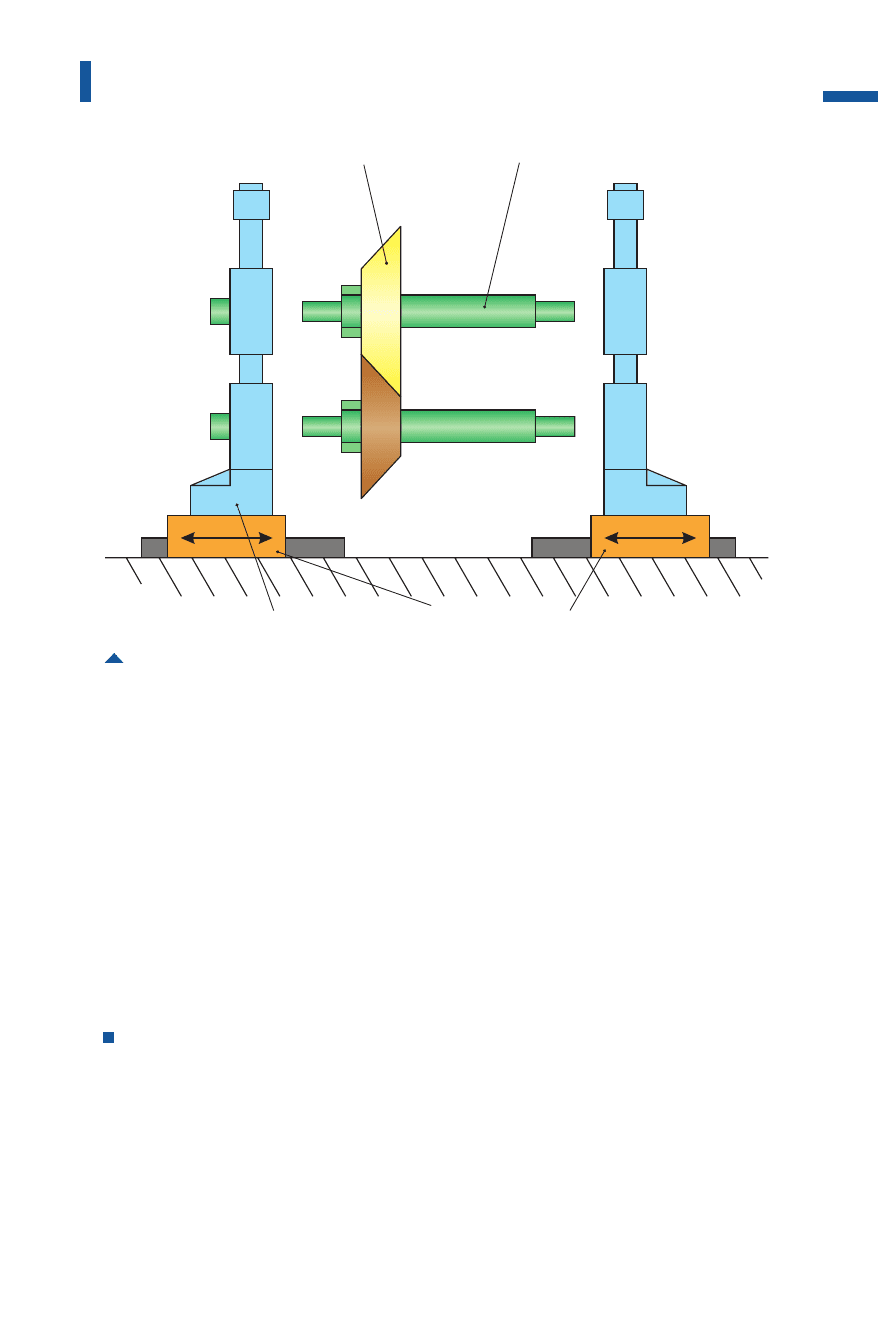
stands, for example three or four, are mounted in a fixed setting on
pallets together with the rolls. The pallets are raised using a crane. For
fastening and centering, mechanical or hydraulic systems are used
depending on the level of automation.
–Exchange of individual pallets or complete sets of rolls and stand
bearings: For fully automatic resetting, the tool pallets are exchanged
using a rack handling system. This method is more economical
where frequent resettings are required.
4.8.3Roller straightening
Straightening is required wherever plastically deformed sheet metals,
bars, wires or pipes have to be straightened. A typical application is the
straightening of sheet metal in a straightening machine for further pro-
cessing in a forming press after being taken off the coil (cf. Sect. 4.3).
383
Bending
Fig. 4.8.23 Work shaft exchange
frame
forming roll work shaft
width adjustment
Metal Forming Handbook / Schuler (c) Springer-Verlag Berlin Heidelberg 1998
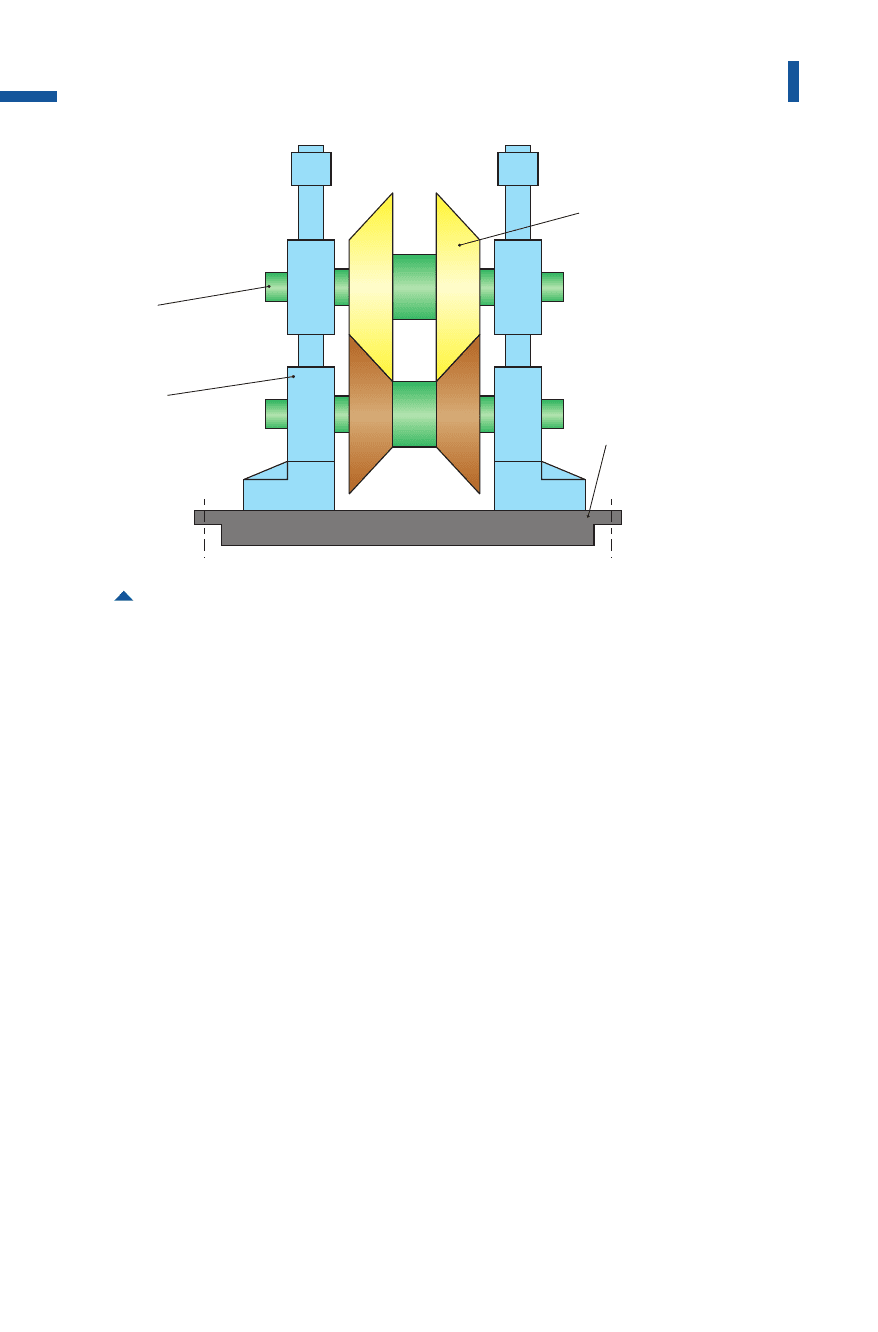
In accordance with DIN 8586, roller straightening is classified as a
bending process using rotating tool motion (cf. Fig.2.1.3).Bending
back unwanted curvature by means of a precisely defined bending
process which must be exactly coordinated with the starting radius has
proven to be impossible in practice. Instead, the technique used
straightens the metal by imparting alternating bending operations
using gradually increased bending radii. This technique is known as
roller straightening (Fig. 4.8.25).
Bending and counter bending must each take place within the plastic
range of the material in order to ensure that the bending direction
is retained following elastic recovery, i.e. the yield strength of the mate-
rial must be exceeded. On the other hand, care must be taken to ensure
that the straightened material does not sustain damage. If bending
is too pronounced, brittle materials can develop slight cracks at the
surface. The last roller must be set in such a way that it causes the
bending process which generates a flat sheet following elastic recovery
(Fig. 4.8.26).
As a result of alternate bending, the residual stress in the sheet mate-
rial is reduced as the number of bending processes and the bending
384
Sheet metal forming and blanking
Fig. 4.8.24 Stand for a complete stand exchange
frame
shaft
forming roll
base plate
Metal Forming Handbook / Schuler (c) Springer-Verlag Berlin Heidelberg 1998
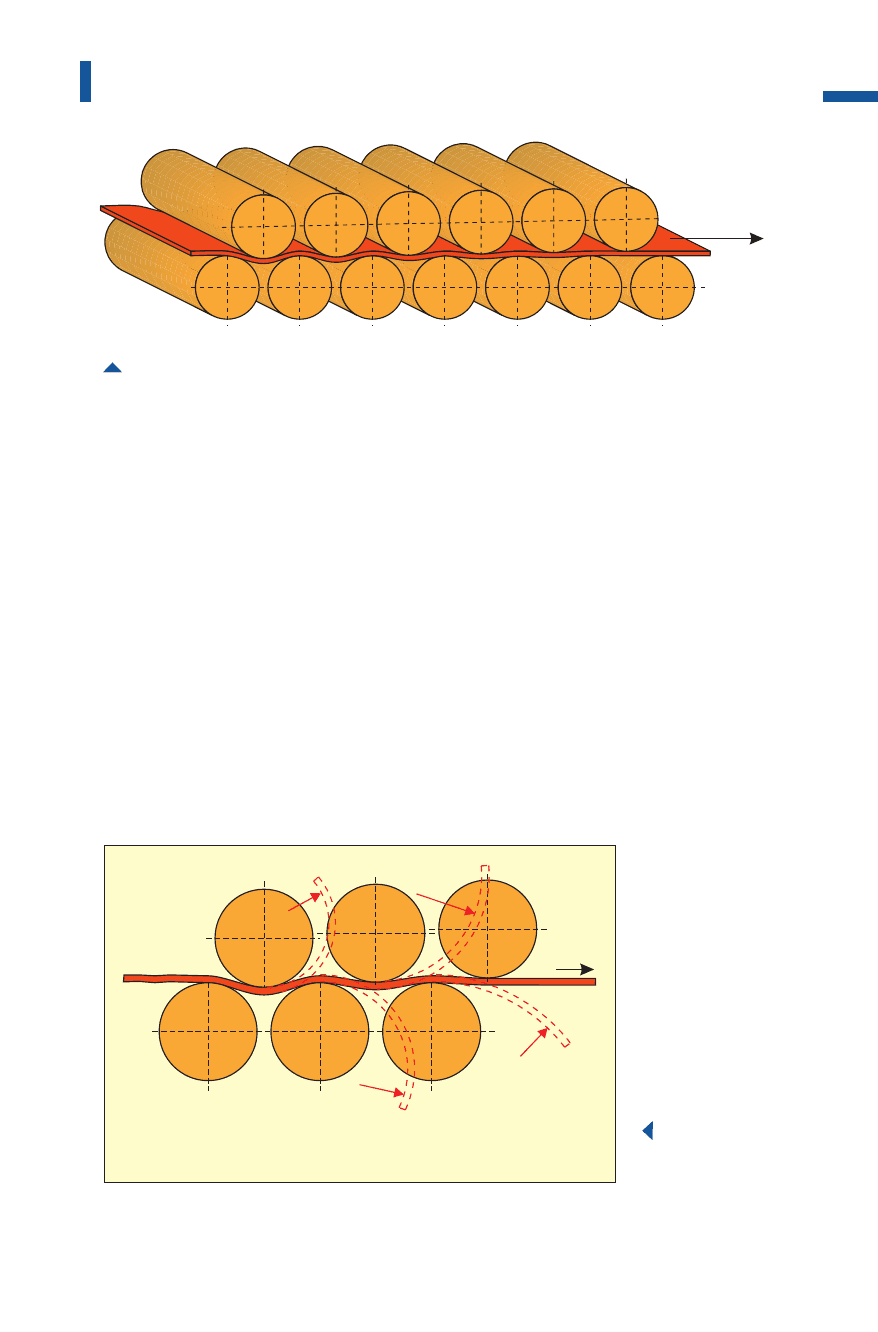
radii increase. The reduction of residual stress is highly beneficial for
further processing (Fig.4.8.27).The larger the number of rollers used,
the lower is the residual stress in the sheet metal after straightening.
In all roller straightening machines, there are two rows of straighten-
ing rollers arranged in offset formation relative to each other. These are
called the upper and lower rollers. The distance between roller centers is
known as the roller pitch t
w
and varies in different machines, as does the
roller radius R
w
and the number of straightening rollers. Straightening
machines with a minimum of five rollers are used. Five straightening
rollers are sufficient to straighten thick plates or coils, or where no special
demands are made on straightening accuracy. Where thinner materials
or more stringent straightening requirements are involved, for example
385
Bending
Fig. 4.8.25 Roller straightening with 13 rollers
R
1
R
2
R
4
R
3
R
1
R
2
R
4
R
3
<<<
Fig. 4.8.26
Alternate
bending
Metal Forming Handbook / Schuler (c) Springer-Verlag Berlin Heidelberg 1998
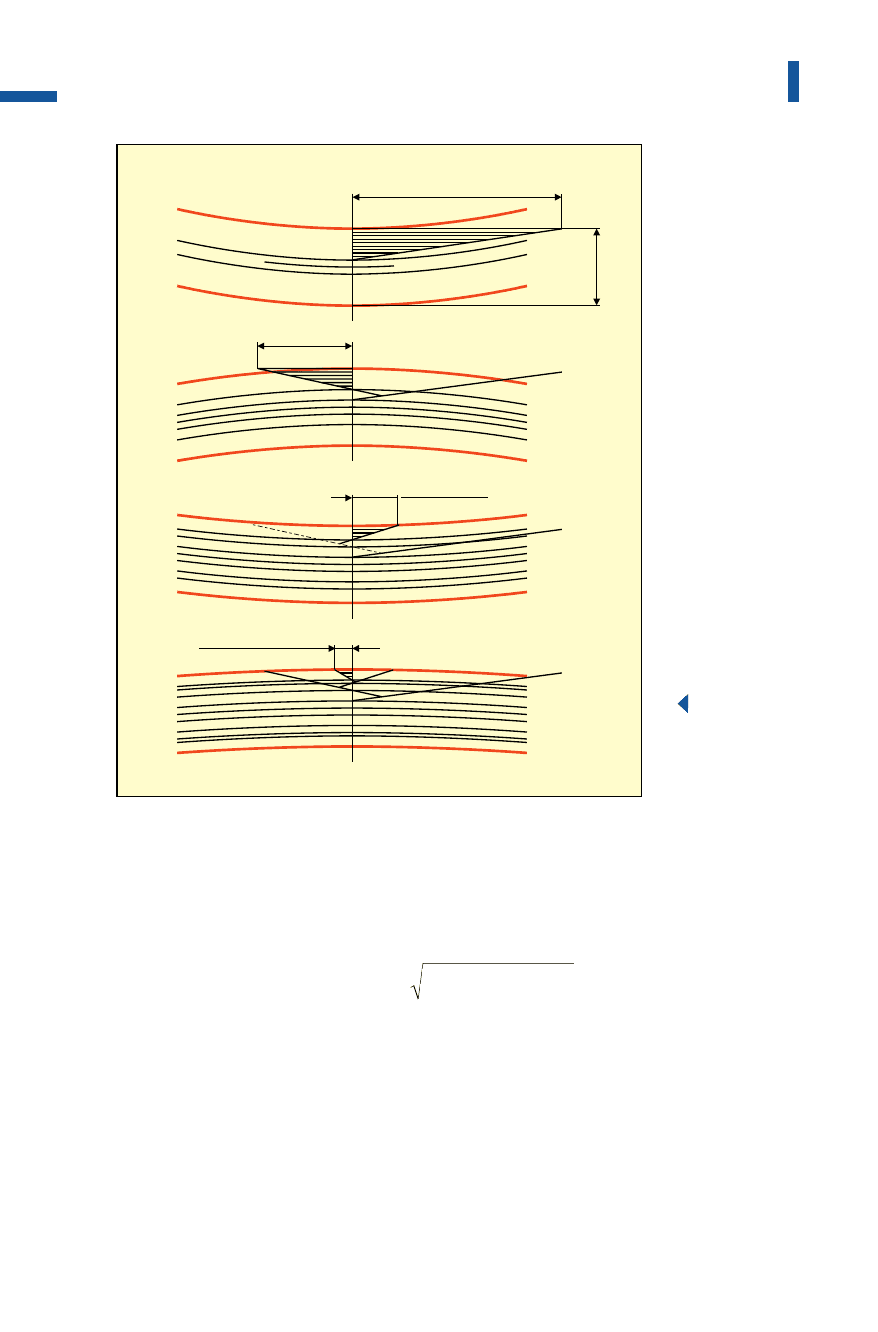
for fine blanking, machines with up to 21 rollers are used. The feed
value z
w
for the rollers is limited by the geometry of the straightening
machine(Fig. 4.8.28):
with the roller radius R
w
[mm], sheet metal thickness s [mm] and roller
pitch t
w
[mm].
In addition to the limits imposed by the roller radius and pitch, the
material properties also have to be taken into account; when processing
brittle aluminium, for instance, in order to avoid cracking the material
it is important not to select the smallest bending radius.
386
Sheet metal forming and blanking
plastic alteration of length
COMPRESSION
plastic alteration of length
COMPRESSION
plastic alteration of length
TENSION
plastic alteration of length
TENSION
1. bend
2. bend
3. bend
4. bend
n
e
u
t
r
a
l
f
i
b
e
r
e
n
o
z
c
i
t
s
a
l
e
sheet metal
thickness
Fig. 4.8.27
Residual
stresses in
the sheet
metal
zRsRstmm
ww wwmax
––=⋅+ ⋅+
()
[]
22
2
2
Metal Forming Handbook / Schuler (c) Springer-Verlag Berlin Heidelberg 1998
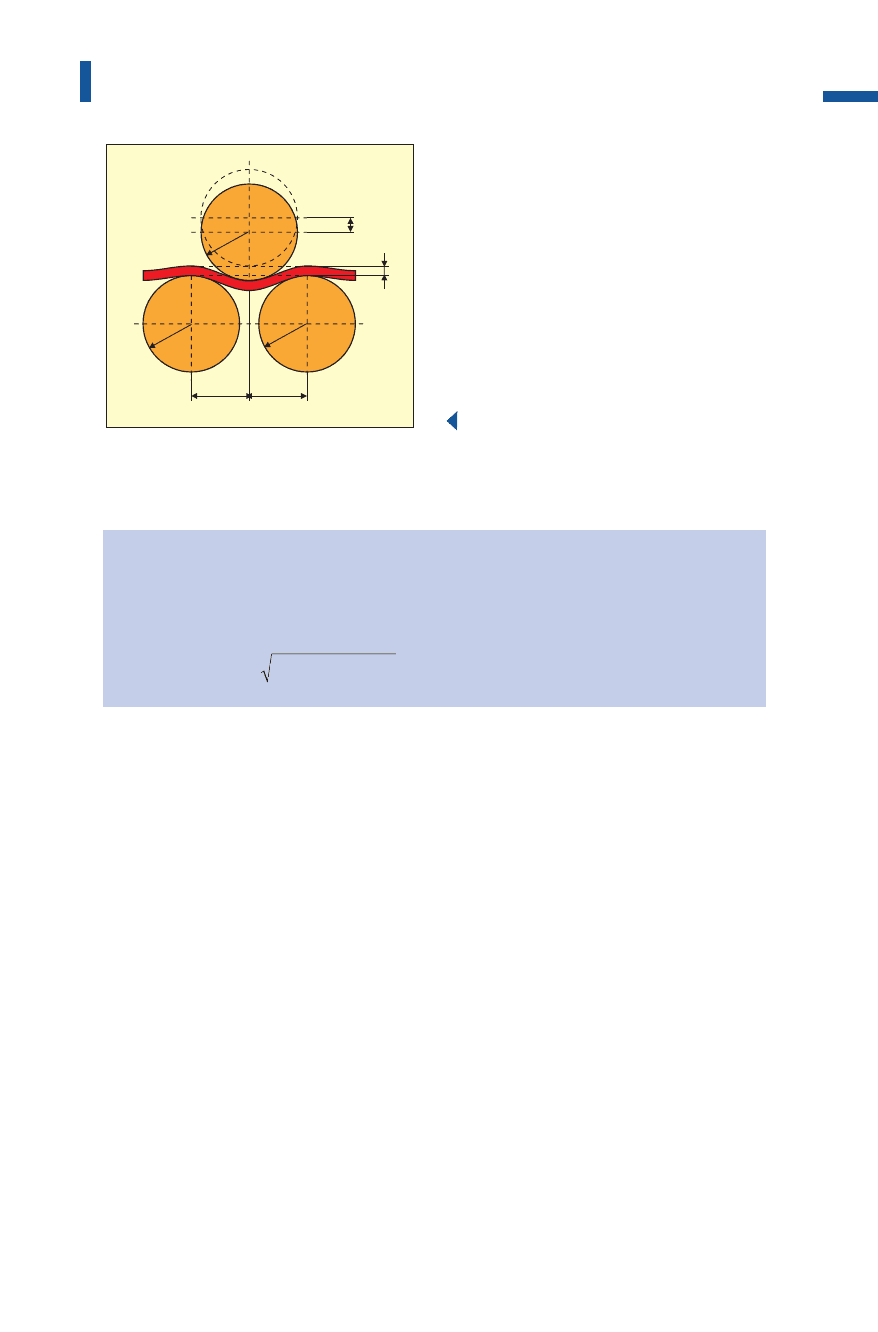
Example:
Sheet steel St 37 (material number 1.0037) with a thickness of 2 mm has to be
straightened. The straightening roller pitch of the straightening machine is t
w
=
22 mm, the roller diameter R
w
= 20 mm. The maximum feed value is calculated as
Roller straightening machines
Generally speaking, roller straightening machines for straightening sheet
metal comprise an upper and a lower row of straightening rollers with
the same diameter. The two rows are generally arranged horizontally. The
rollers in the top row are generally arranged precisely above the gaps
between the rollers of the bottom row.
To allow modification of the rolling gap, the upper rollers must be
adjustable in height. The type of adjustment characterizes the straight-
ening machine type. While in one case each upper roller can be sepa-
rately height adjustable, in the other type of machine all the upper
rollers are grouped together in a block to form an assembly, and are fed
towards the lower rollers by a tilting motion of the block.
The thickness range, the yield strength and the modulus of elasticity
of the coil stock to be processed determine the diameter and pitch of
the straightening rollers. In the case of materials with particularly sen-
sitive surfaces, intermediate rollers embedded between the straighten-
387
Bending
z
Wmax
tt
s
R
W
R
W
R
W
Fig. 4.8.28 Straightening roller geometry
zmm
w max
––.=⋅ + ⋅ +
(
)
=220 2 220 2 22 62
2
2
Metal Forming Handbook / Schuler (c) Springer-Verlag Berlin Heidelberg 1998

ing and support rollers are used in order to avoid damaging the sheet
surface. With the help of straightening rollers with crowning capabili-
ty, waviness at the edges and center of the material can be eliminated.
The first pair of rollers must cause plastic deformation of the material,
but a certain roller diameter must not be exceeded. The thickness of a
straightenable sheet metal is accordingly calculated from the maximum
straightening force and the torque, which in turn is determined by the
size of the cardan shafts between the gear and rollers and the roller
diameter. As neither the gear nor the cardan shafts can be enlarged at
will for space reasons, the sheet thickness range and accordingly also
the flexibility of straightening machines with rollers of equal size are
restricted. This range can be extended by approximately one and half
times if individual rollers can be disengaged. Using the further devel-
oped roller system depicted in Fig. 4.8.29with different roller diame-
ters, it is possible to straighten sheet metals from 0.5 to 20 mm in thick-
ness.
388
Sheet metal forming and blanking
Fig. 4.8.29 Roller straightening machine for larger sheet metal thickness range
feedrolls
heightdisplay
liftcylinder
feedspindle
straightening
rollerswith
different
diameters
Metal Forming Handbook / Schuler (c) Springer-Verlag Berlin Heidelberg 1998

4Sheet metal forming and blanking
4.9Organization of stamping plants
4.9.1Design
Sheet metal stamping plants are among the most capital-intensive of all
manufacturing installations in industry. The high degree of investment
necessary and long-term commitment to selected manufacturing meth-
ods mean that careful investment and production planning are essen-
tial. In the production of sheet metal parts using deep drawing, stretch
drawing and blanking processes, major criteria include part accuracy,
die life, line output and its availability. The implementation of mea-
sures for continuous in-process quality assurance using suitable sensor
technology allows objective assessment of part quality (cf. Sect. 4.9.3).
Stamping plants generally comprise different sheet metal process-
ing equipment, each of which manufactures a certain range of parts
(Fig. 4.9.1).The aim of efficient stamping plant layout is to ensure the
most economical operation possible. The selection of the individual
equipment depends primarily on the size, shape and metal forming
requirements imposed on the components, as well as the planned
batch sizes.
The sheet metal is supplied from the rolling mill in the form of coil.
When producing medium-sized to large parts such as bathtubs, sinks,
car doors or roofs, a separate blanking line cuts the blanks from the coil
stock and stacks them (cf. Fig.4.6.5).The blanks are destacked by the
blankloader (cf. Fig. 4.4.15and 4.4.16)and fed individually and auto-
matically into the press where they are formed. Due to its high capacity,
a blanking line is able to service several press lines (cf. Fig. 4.4.19)or
large-panel transfer presses (cf. Fig. 4.4.27and 4.4.38).
Metal Forming Handbook / Schuler (c) Springer-Verlag Berlin Heidelberg 1998
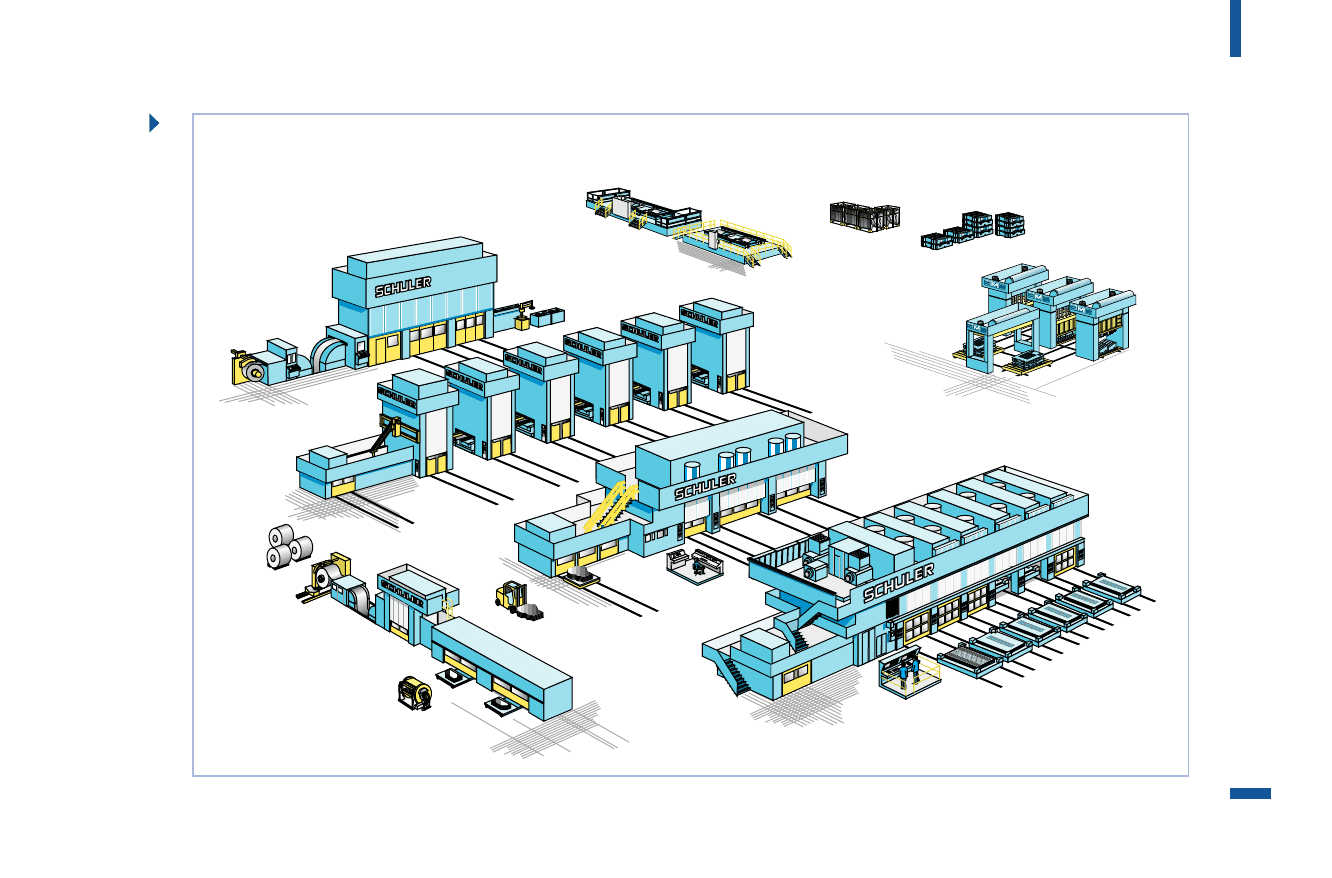
390
Sheet metal forming and blanking
crossbar transfer press
tri-axis transfer press
press line
try-out center
storage of dies
storage of
finished parts
transfer
simulators
transfer press
for small and
medium-sized
parts
coils
blanking line
blank stack
turnover device
Fig. 4.9.1 Stamping plant for the manufacture of large sheet metal parts
Metal Forming Handbook / Schuler (c) Springer-Verlag Berlin Heidelberg 1998
